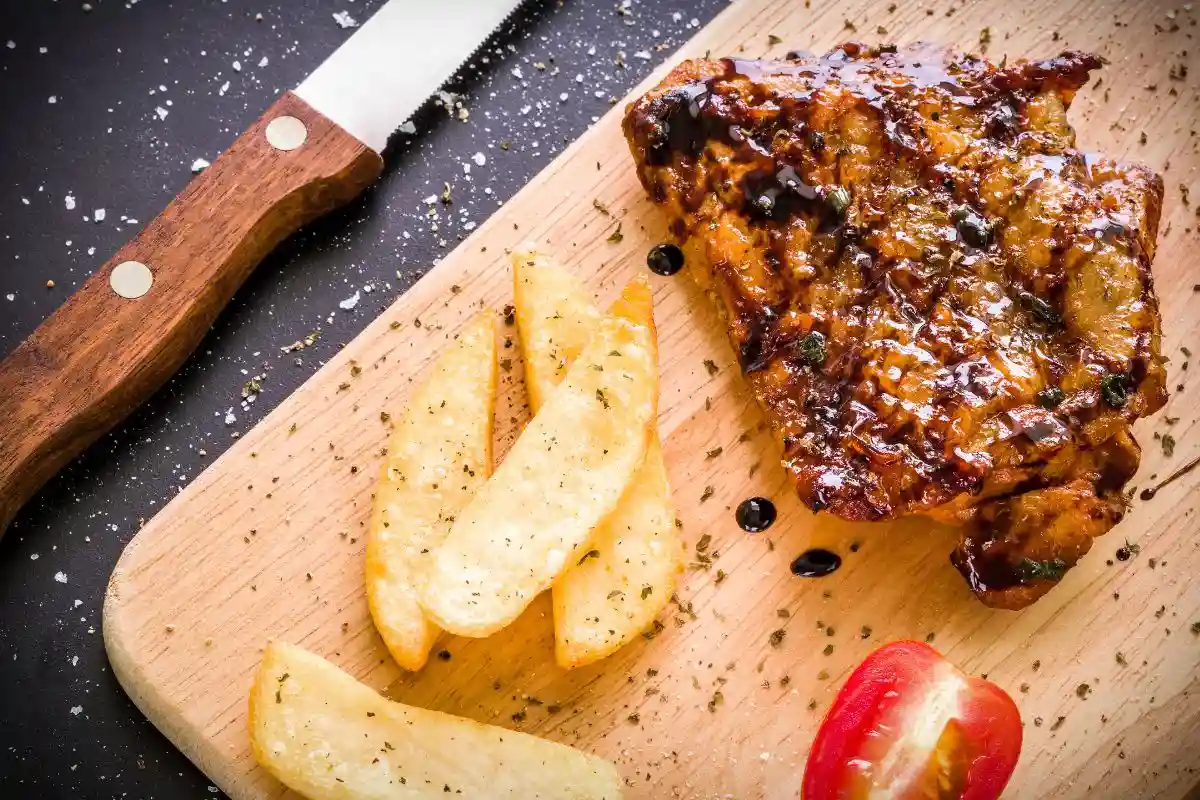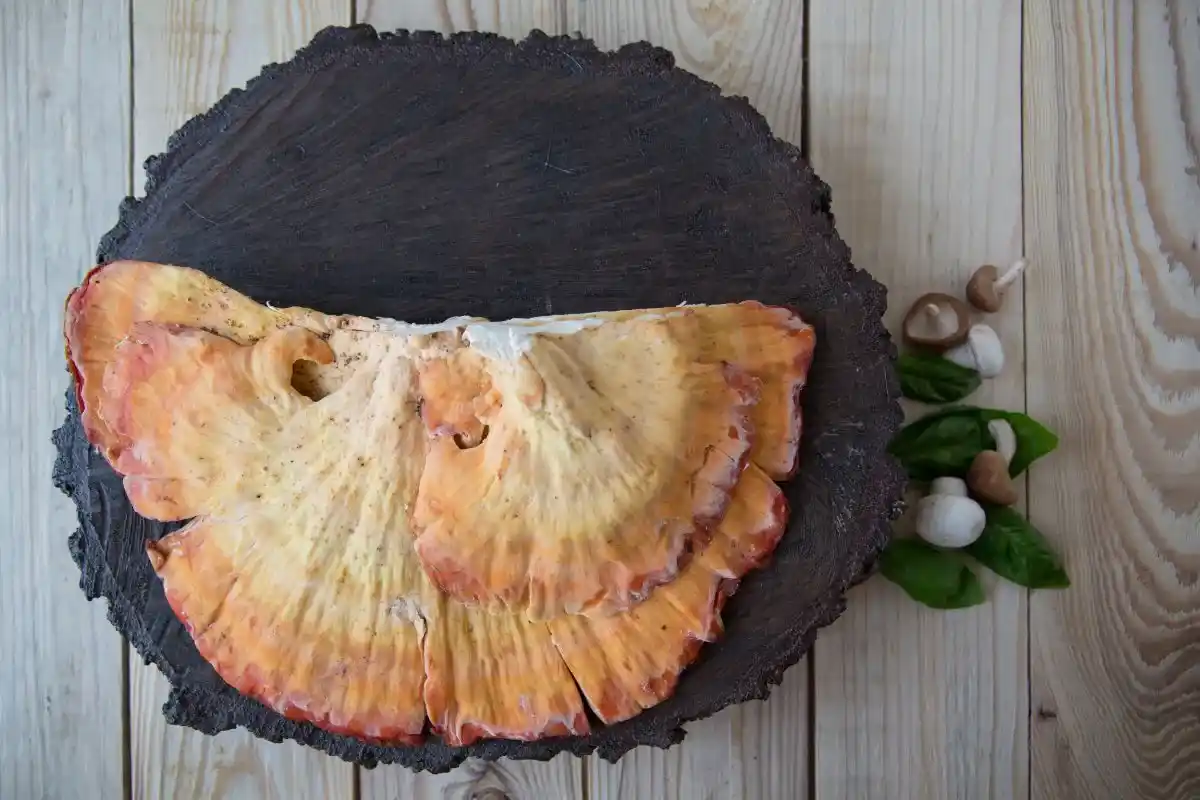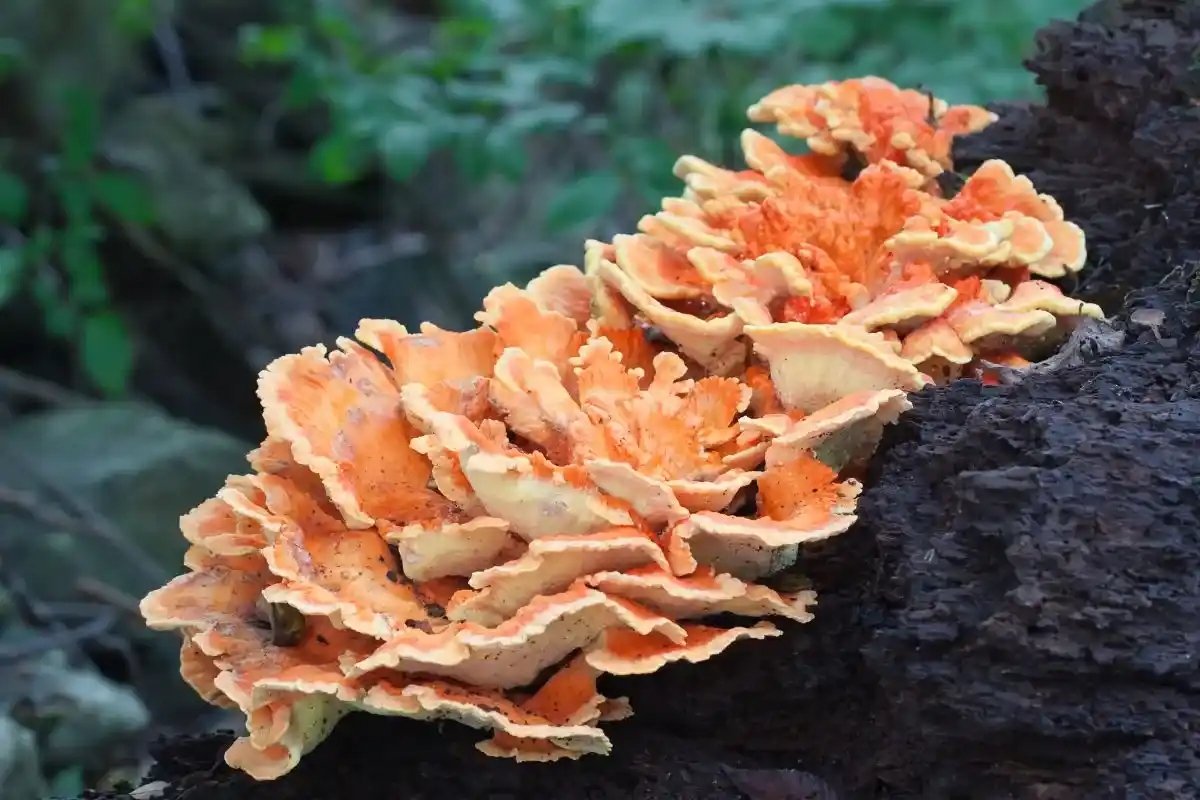Introduction to Chicken of the Woods
Chicken of the Woods is more than just a mushroom; it’s a culinary journey waiting to be explored. This remarkable fungus, known scientifically as Laetiporus, boasts a vibrant orange hue that is hard to miss in the wild. Its name is not just fanciful; it’s a testament to its taste and texture, which are reminiscent of chicken, making it a favored ingredient among chefs and foragers alike.
What Makes Chicken of the Woods Stand Out?
- Taste and Texture: Unlike typical mushrooms, Chicken of the Woods offers a meaty texture. Its ability to mimic the taste of chicken makes it a popular choice for vegetarian and vegan dishes.
- Nutritional Value: Rich in protein, fiber, and vitamins, this mushroom is not only a treat to the taste buds but also a boon for health-conscious individuals.
- Versatility in Cooking: Whether sautéed, baked, or stewed, Chicken of the Woods adapts beautifully to various recipes, enhancing dishes with its unique flavor profile.
Culinary Uses and Appeal
The culinary appeal of Chicken of the Woods lies in its versatility. It’s a star ingredient in a wide range of dishes:
- Vegetarian and Vegan Dishes: Its meat-like texture makes it an excellent substitute for chicken in recipe, appealing to those on plant-based diets.
- Gourmet Meals: High-end restaurants often feature this mushroom for its exotic appeal and delightful taste.
- Home Cooking: From simple sautés to elaborate meals, Chicken of the Woods elevates everyday cooking with its unique flavor.
Why It’s a Forager’s Delight
Foraging for Chicken of the Woods is an adventure that offers culinary rewards:
- Ease of Identification: Its distinctive color and growth on oak trees make it one of the easier mushrooms to identify safely.
- Abundance: When you find it, you’re likely to discover a bounty, as it grows in large brackets that can be harvested in generous amounts.
The Sustainable Choice
Chicken of the Woods not only enriches our plates but also supports sustainable eating habits. By foraging this wild mushroom, we tap into a natural, renewable resource that encourages us to engage with our environment thoughtfully.
Incorporating Chicken of the Woods into Your Cooking
- Start Simple: Try substituting it for chicken in your favorite recipes.
- Experiment: Explore its versatility by using it in soups, stews, stir-fries, and even as a pizza topping.
- Preservation: For year-round enjoyment, learn to dehydrate or freeze this mushroom effectively.
A Mushroom Like No Other
Chicken of the Woods isn’t just a food item; it’s a culinary experience that connects us with nature, offers health benefits, and delights our taste buds with its unique flavor and texture. Whether you’re a seasoned forager or a curious cook, exploring chicken of the woods recipe can transform your culinary adventures with its unparalleled taste and versatility.
History and Background
Chicken of the woods, a vibrant and meaty mushroom, has woven itself into the fabric of various cultures worldwide. Its striking appearance and resemblance to chicken in both taste and texture have made it a forager’s treasure and a culinary delight. Throughout history, people have celebrated this mushroom for its versatility and nutritional value, integrating it into traditional dishes and medicinal practices.
The Culinary Journey
- Historically, foragers prized chicken of the woods for its meat-like qualities. It became a popular meat substitute, especially valuable during times of scarcity or fasting periods in different cultures.
- Traditional recipes often featured this mushroom, thanks to its hearty, protein-rich contribution to meals.
Medicinal Uses
- People also recognized chicken of the woods for its potential healing properties. They believed it could help with inflammation and fight off infections.
- Traditional medicine used it to tackle various health issues, from digestive problems to skin infections, leveraging its antioxidant and beneficial compounds.
Cultural Significance
- The mushroom’s unique colors and shape also played a role in folklore and cultural ceremonies, symbolizing vitality and longevity.
- Finding a chicken of the woods mushroom was often seen as a sign of good luck or an indication of coming prosperity.
Conservation and Modern Foraging
- Today, a renewed interest in foraging and sustainable foods has brought chicken of the woods back into the spotlight. Both foragers and chefs cherish it for its flavor and culinary flexibility.
- This resurgence highlights the mushroom’s enduring appeal and its role in contemporary cuisine.
The Mushroom in Modern Cuisine
- Nowadays, chefs and home cooks alike celebrate chicken of the woods for its adaptability in recipe. From sautéing to complex dishes, it excels in various cooking methods.
- Its ability to absorb flavors well makes it a versatile ingredient across numerous cuisines. Vegetarians and vegans particularly appreciate it as a substantial meat alternative.
Exploring chicken of the woods recipe not only delights the palate but also connects us to the rich historical and cultural stories of this fascinating mushroom. Whether through foraging, cooking, or pursuing a sustainable lifestyle, chicken of the woods offers a unique experience. It enriches every dish, bridging the natural world with our culinary traditions and bringing a taste of history to our tables.
Culinary Exploration
The quest for chicken of the woods recipe opens a fascinating chapter in culinary exploration. This unique mushroom offers an extraordinary blend of flavor and versatility, making it a prized ingredient in many dishes. But before it graces the kitchen, the journey begins in the wild, where identifying and foraging this mushroom correctly is crucial.
Identifying and Foraging for Chicken of the Woods
- Chicken of the woods can be easily spotted by its bright orange to yellow colors and shelf-like formation on trees. Its vibrant hues make it stand out in the forest landscape.
- This mushroom typically grows on dead or dying hardwood trees. Oak is a common host, but it can also be found on yew, cherry, and chestnut.
- Safety first: Ensure it’s the correct species. Chicken of the woods should have a soft, almost suede-like surface and pores underneath, not gills. If unsure, consult with an expert before consumption.
- Foraging should be done responsibly. Harvest only what you need, and avoid taking young mushrooms to allow them to mature and spread spores.

Preparation Basics
Once foraged, preparing chicken of the woods for cooking is straightforward yet important for both taste and safety.
Cleaning
- Begin by gently brushing off any dirt or debris. Since the mushroom is porous, it’s best to avoid washing it under running water to prevent it from becoming waterlogged.
- Trim away any tough or woody parts. The edges are usually the most tender.
Preparing for Cooking
- Slice the mushroom into manageable pieces. This not only makes it easier to cook but also helps in removing any remaining dirt.
- Some prefer to blanch the mushroom first to soften it and reduce its strong flavor. This involves boiling it in water for a few minutes and then plunging it into ice water.
- Pat the pieces dry before cooking. This helps in achieving a better texture, especially if you’re aiming for a crispy exterior.
Cooking chicken of the woods opens up a world of possibilities. From simple sautés to complex sauces, this mushroom adapts well to various cooking methods. Its meaty texture makes it an excellent substitute for chicken in vegetarian and vegan dishes, hence its popularity in chicken of the woods recipe. Whether you’re aiming for a comforting soup, a hearty stew, or a tantalizing stir-fry, chicken of the woods brings a touch of the wild to your culinary creations. With its nutritional benefits and unique flavor profile, it’s a mushroom that invites both novice cooks and seasoned chefs to explore the depths of natural, plant-based cooking.
Recipe Section
Exploring the culinary versatility of Chicken of the Woods reveals a world of flavor and innovation. This section highlights three must-try recipes that showcase this unique mushroom’s adaptability and appeal.
Sautéed Chicken of the Woods
The simplest way to enjoy Chicken of the Woods is by sautéing it. This method brings out the mushroom’s natural flavors, making it a perfect side dish or a plant-based protein option.
- Ingredients: Olive oil, garlic, sliced Chicken of the Woods, salt, and pepper.
- Method: Heat olive oil in a pan, add garlic, and sauté until fragrant. Add the sliced mushroom, seasoning it with salt and pepper. Cook until golden brown.
- Serving Suggestion: Serve as a side or incorporate into pasta dishes for a hearty meal.
Chicken of the Woods Pizza
Transform your pizza night with a Chicken of the Woods topping. Its meaty texture and rich flavor make it an excellent chicken substitute.
- Base: Use your favorite pizza dough, spread with a tomato or white garlic sauce.
- Toppings: Add sautéed Chicken of the Woods, mozzarella cheese, red onions, and arugula.
- Cooking: Bake in a preheated oven until the crust is crispy and the cheese melts.
- Final Touch: Drizzle with balsamic glaze for an extra flavor punch.
Vegan Chicken of the Woods Stir-fry
This stir-fry is a vibrant, nutritious meal that spotlights Chicken of the Woods in a medley of vegetables and sauces.
- Ingredients: Sliced Chicken of the Woods, bell peppers, broccoli, carrots, soy sauce, ginger, and garlic.
- Method: Start by sautéing the mushroom until it’s slightly crispy. Remove it from the pan and then stir-fry the vegetables. Add the mushroom back in, along with soy sauce, ginger, and garlic. Cook until everything is well-coated and tender.
- Serving: Enjoy over rice or noodles for a complete meal.
Preservation Techniques
Discovering a chicken of the woods recipe that delights the palate is only part of the journey. Preserving this versatile mushroom for future culinary creations is equally important. Dehydration stands out as a favored method for extending the shelf life of chicken of the woods, ensuring that its unique flavor and texture can be enjoyed year-round.
Dehydrating Chicken of the Woods
- Selecting Mushrooms: Start with fresh, undamaged specimens. The fresher the mushroom, the better the quality of the dehydrated product.
- Cleaning: Gently brush off any dirt or debris. Avoid washing with water to prevent the mushrooms from absorbing moisture, which can affect the dehydration process.
- Slicing: Cut the mushroom into even slices, about ¼ inch thick. Consistent thickness ensures even drying.
- Drying Method: Use a dehydrator or an oven set to the lowest temperature. Spread the slices in a single layer on the drying racks.
- Dehydration Time: Dehydrating can take several hours, depending on humidity levels and the thickness of the slices. The goal is to remove as much moisture as possible without cooking the mushroom.
- Testing for Dryness: The slices should be brittle or very leathery with no soft spots. Properly dehydrated mushrooms should not bend or feel moist.
Storing Dehydrated Chicken of the Woods
- Cooling: Allow the dehydrated slices to cool completely before storing. Warm mushrooms can condense moisture when sealed, leading to spoilage.
- Airtight Containers: Store the dried mushrooms in airtight containers. Glass jars with tight-fitting lids work well to keep out moisture and pests.
- Labeling: Label the containers with the date of dehydration. Properly dried mushrooms can last for a year or more, but it’s helpful to track how long they’ve been stored.
- Dark, Cool Storage: Keep the containers in a cool, dark place. Exposure to light and heat can degrade the quality over time.
- Rehydrating: When ready to use, rehydrate the mushrooms by soaking them in warm water or broth for about 20 to 30 minutes. They can then be added directly to your chicken of the woods recipe.
By following these preservation techniques, you can enjoy the taste and nutritional benefits of chicken of the woods long after the foraging season has ended. Dehydrating not only extends the shelf life but also concentrates the flavors, making for an even more delicious addition to meals. Whether incorporated into soups, stews, or stir-fries, dehydrated chicken of the woods adds a rich, umami-packed punch to dishes, elevating them from ordinary to extraordinary. With these simple steps, you can ensure that this cherished wild mushroom is always on hand, ready to enhance your culinary adventures.

FAQ’s
What is the best way to cook Chicken of the Woods?
Sautéing to Perfection
- The best method to cook Chicken of the Woods is by sautéing. This technique highlights its chicken-like texture and rich flavor. Start with a hot pan, a touch of oil, and some garlic or onions for added depth.
How do you eat Chicken of the Woods?
Versatile Culinary Uses
- Chicken of the Woods can be enjoyed in various ways:
- As a meat substitute in vegan and vegetarian dishes
- Stir-fried with vegetables
- Added to soups and stews
- As a pizza topping for a unique flavor twist
What can you mistake Chicken of the Woods for?
Lookalikes to Be Aware Of
- While distinct, Chicken of the Woods can sometimes be confused with:
- The Jack O’Lantern mushroom, which is toxic
- Ensure you’re foraging with an experienced guide or use a reputable foraging guidebook.
Is Chicken of the Woods good for you?
A Nutritional Powerhouse
- Yes, it’s not only delicious but also packed with nutrients:
- High in protein, fiber, and vitamins
- Low in fat, making it a healthy choice
When should you not eat Chicken of the Woods?
Safety First
- Avoid eating Chicken of the Woods if:
- It’s growing on coniferous trees, as it may absorb toxins
- It appears old or overly soggy
- You notice any signs of decay or insect infestation
Can you undercook Chicken of the Woods?
Cooking It Right
- While undercooking is less of a concern compared to meat, it’s essential to cook Chicken of the Woods thoroughly to:
- Enhance its flavor
- Improve its texture
- Ensure it’s easily digestible
Is Chicken of the Woods psychoactive?
Just a Mushroom, Nothing More
- No, Chicken of the Woods is not psychoactive. It’s prized for its taste and texture, not for any mind-altering effects.
To enrich your understanding and culinary skills with Chicken of the Woods, explore more on Delicious Chef, where gourmet meets everyday cooking.
For more foraging tips, check out Mushroom Appreciation – “Foraging Chicken of the Woods” and to dive deeper into mushroom nutrition check this Healthline – “The Nutritional Benefits of Edible Mushrooms”.
Conclusion
Exploring the culinary world of Chicken of the Woods reveals a fascinating journey from forest to plate. This unique mushroom not only offers a delicious and healthy alternative to traditional meats but also enriches our cooking with its versatility and depth of flavor. From the best ways to cook and enjoy it, to understanding its nutritional benefits and foraging tips, Chicken of the Woods provides a gateway to sustainable eating and culinary innovation. Whether you’re a seasoned chef or a curious food enthusiast, incorporating this mushroom into your diet opens up a realm of delicious possibilities. By paying attention to safety and preparation tips, you can ensure that every dish is not only flavorful but also a celebration of nature’s bounty. Let the adventure begin in your kitchen with Chicken of the Woods, and discover the joy of cooking with one of nature’s most intriguing offerings.

